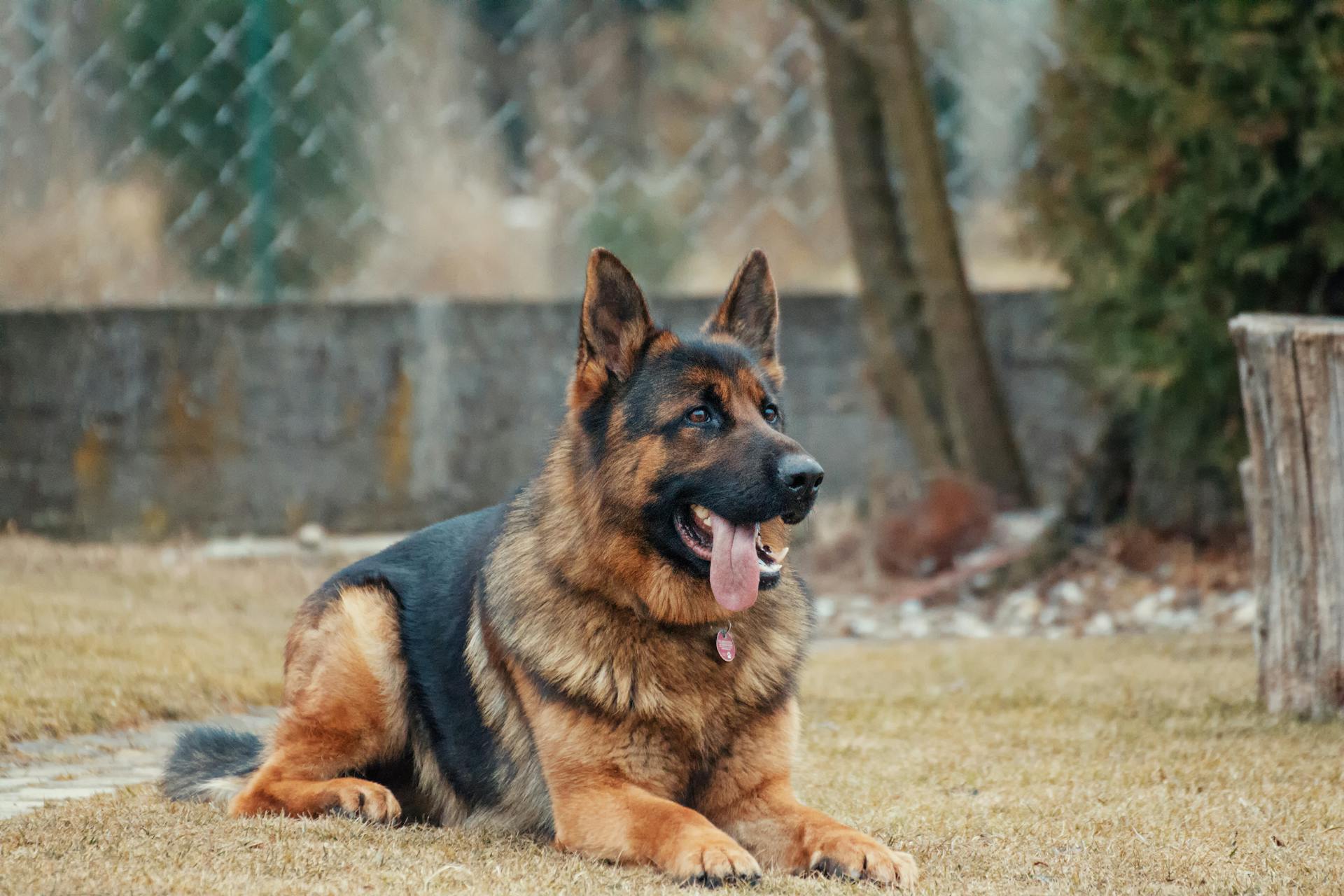
Canine dysfunctional behavior is a complex issue that affects many dogs and their owners. It's estimated that 10-20% of dogs in the United States exhibit some form of dysfunctional behavior.
Dysfunctional behavior in dogs can manifest in various ways, such as separation anxiety, fear-based aggression, or compulsive disorders. These behaviors can be challenging to address, but with the right approach, they can be managed.
The key to understanding canine dysfunctional behavior is to recognize that it's often a learned response to a specific stimulus or environment. For example, a dog may develop separation anxiety if left alone for extended periods without proper training and exercise.
Dogs with dysfunctional behavior may exhibit physical symptoms such as pacing, panting, or destructive behavior. They may also display emotional symptoms like whining, barking, or avoidance behaviors.
Take a look at this: Symptoms of Canine Lupus
Understanding
Canine cognitive dysfunction is a common age-related disease in dogs that affects the brain, causing deterioration similar to Alzheimer's disease in humans.
Check this out: What Is Canine Lupus
Dogs typically start to develop cognitive dysfunction syndrome around nine years of age, or older, and the condition may be underdiagnosed since the behavioral changes progress slowly.
The slow progression of cognitive impairment can make it difficult to recognize, and owners may assume that some changes are a normal part of aging.
Early intervention with environmental enrichment, diet, and medical management can improve the quality of life for dogs affected by cognitive dysfunction syndrome.
Combining several management options, such as environmental or diet changes and nutraceuticals, have been shown to be the most effective treatment for canine cognitive dysfunction.
Take a look at this: Canine Cancer Diet Lymphoma
Clinical Signs and Diagnosis
Dogs with canine cognitive dysfunction may exhibit a range of clinical signs, including disorientation, interaction changes, sleep pattern changes, and house-soiling. These signs can be subtle and may not be immediately noticeable.
Disorientation is a common sign, where dogs may get lost in familiar places, such as their home or yard. They may stare into space or sit in corners, unsure of what to do.
Interaction changes can also occur, where dogs become clingy or avoidant, not recognizing familiar people. This can be a sign of anxiety or fear.
Sleep pattern changes are another common sign, where dogs may wander the house at night or sleep more during the day. This can be a sign of restlessness or confusion.
House-soiling is a common problem, where dogs may urinate or defecate indoors despite being previously house-trained. This can be a sign of disorientation or loss of housetraining.
Other signs of canine cognitive dysfunction may include changes in activity level, such as decreased interest in playing or restlessness. Anxiety, new phobias, irritability, and aggression can also be signs of the disease.
To diagnose canine cognitive dysfunction, veterinarians may use a list of symptoms, including:
- Disorientation – loss of ability to navigate the house or remember where specific places are
- Interaction changes – decreased interest in social interaction
- Sleep/wake cycle Changes – restlessness throughout the night, sleeping during the day
- Housebreaking issues – defecating indoors, not signaling to go outside
- Physical activity level – decreased interest in being outside, decreased responses to stimuli
It's essential to rule out any underlying medical causes for these symptoms, such as thyroid disorders, Cushing's disease, diabetes, kidney disease, or sensory loss.
Causes and Pathophysiology
The brain's high metabolic rate makes it particularly susceptible to oxidative damage, which can lead to a reduction in brain mass and the number of neurons.
This damage is further exacerbated by the brain's relative lack of endogenous antioxidant processes, allowing oxidative stress to take hold and cause significant harm.
The brain's high percentage of polyunsaturated fatty acids also makes it more vulnerable to oxidative damage, which can result in the formation of beta-amyloid plaques.
These structural and functional changes are thought to be the underlying cause of the clinical signs associated with canine cognitive dysfunction, similar to those seen in human patients suffering from Alzheimer's disease.
Here's an interesting read: Canine Brain Cancer Symptoms
Presentation and Etiology
Presentation and Etiology can be complex, but let's break it down.
Symptoms of the condition often include a distinctive rash, fever, and swollen lymph nodes.
The rash typically starts as a red, itchy patch on the skin, which can spread to other areas.
Research suggests that the condition is caused by a combination of genetic and environmental factors.
Genetic predisposition plays a significant role, with certain genetic mutations increasing the risk of developing the condition.
Studies have shown that exposure to certain toxins and allergens can trigger the condition in susceptible individuals.
The exact mechanism of the condition is not yet fully understood, but it's believed to involve an abnormal immune response.
Consider reading: Why Is My Dog Scared of a Certain Person
Pathophysiology
The brain is very susceptible to oxidative damage due to its high metabolic rate, relative lack of endogenous antioxidant processes and high percentage of polyunsaturated fatty acids.
Oxidative damage leads to structural and functional changes in the brain. This can result in a reduction in brain mass and the number of neurons.
Neuroaxonal degeneration and the formation of beta-amyloid plaques are also consequences of oxidative damage. These changes can lead to a decline in endogenous antioxidants.
In canine patients, we see several histopathological changes similar to those seen in human patients suffering Alzheimer’s disease. These changes are likely responsible for the clinical signs associated with cognitive dysfunction.
Suggestion: Canine Brain Anatomy
Systemic Disease

Systemic disease can be a sneaky culprit, masquerading as CCD. Reduced activity levels can be caused by dysfunction in the cardiovascular system.
Dysfunction in the respiratory system can also lead to reduced activity levels in dogs. This can be a result of various conditions, such as chronic bronchitis or asthma.
The renal system can also be a contributing factor, with kidney disease or failure leading to lethargy and decreased mobility. In these cases, the veterinarian must be careful not to approach the case with a preconceived idea as to the cause.
Dysfunction in the endocrine system, such as hypothyroidism, can also cause signs that mimic CCD. The potential role of CCD alongside these conditions must be considered if the dog is of the right age.
Normal Decline
As we age, our furry friends will experience a decline in cognition, just like us. This is a normal part of the aging process.
Some dogs will remain in cognitive decline, whereas others will show signs of dysfunction. It's essential to keep an eye on your dog's behavior and cognitive abilities.
Dogs with normal cognitive decline may not exhibit any noticeable symptoms, but it's still crucial to monitor their condition.
For your interest: Canine Cognitive Dysfunction
Sensory Changes
Loss of hearing, vision, and smell can be indicative of other issues, not just CCD.
A dog with compromised vision may become reluctant to exercise or stay closer to its owners on walks.
Altered senses can be a sign of other underlying problems that need to be addressed.
A thorough physical examination and history taking can help assess the role of altered senses in a dog's overall health.
A dog with compromised vision may appear disorientated or have trouble navigating its surroundings.
Related reading: Dog Vision Loss
Management of Osteoarthritis
Managing osteoarthritis in dogs with canine cognitive dysfunction requires a multi-faceted approach. Early intervention is key to slowing the progression of the disease and improving mental and physical function.
Veterinary nurses and surgeons play a vital role in detecting and communicating the early signs of disease. Regular check-ups with your veterinarian can help identify any underlying issues that may be contributing to your dog's osteoarthritis.
Modifying your dog's home environment can make a huge difference in their quality of life. This can include making easier access to resources such as food and water, increasing the frequency of toilet trips, and using rugs or yoga mats to prevent slipping.
The use of feeding puzzles and other forms of mental stimulation can be especially helpful when walks are limited by mobility. These activities can help reduce anxiety and improve cognitive function.
Physical therapy and massage can also be beneficial in managing osteoarthritis. These treatments can enhance the pet-owner bond and provide mental stimulation, as well as support for osteoarthritis.
Here are some specific modifications you can make to your dog's home environment:
- Easier access to resources such as food and water
- Increased frequency of toilet trips
- Improved bedding and padded surfaces
- Keeping a regular routine
- Avoiding hard, slippery floors
- Use of feeding puzzles and other forms of mental stimulation
- Retraining with modified cues
- More frequent but shorter exercise sessions outdoors
- Use of aids such as pushchairs when mobility is severely limited
- Thundershirts to help with anxiety
- Physical therapy and massage
Pharmacological Interventions
Pain control is essential wherever pain is suspected to be contributing to clinical signs, and multimodal approaches to pain management are commonly required.
Selegiline can be used at a dose of 0.5-1mg/kg PO q24h for at least two months, which has antioxidant and neuroprotective effects and can improve neurotransmitter function.
It may also enhance learning and is indicated for use in CCD, especially when signs of anxiety and/or social withdrawal are seen.
Propentofylline can improve cerebral circulation and has antioxidant and neuroprotective effects, making it particularly useful in combination with selegiline and dietary management.
However, this drug should be used with care in animals with heart disease.
Clomipramine improves neurotransmitter function, making it useful for the management of anxiety, but it's contraindicated when used with selegiline.
Support and Care
If your dog is suffering from canine cognitive dysfunction, it's essential to work with your veterinarian to develop a support plan. This plan may include dietary changes, supplementation, and medications to help slow the progression of the condition.
Your vet will need to see your dog periodically to evaluate their response to therapy and monitor any other diseases present. Regular check-ups will also give you the opportunity to ask questions and get guidance on caring for your dog.
To support your dog's cognitive function, it's crucial to create an enriching environment. This can be achieved by modifying the home environment and management of the ageing dog. For example, you can provide easier access to resources such as food and water.
A regular routine can also make a huge difference in your dog's quality of life. This includes keeping a consistent schedule for feeding, exercise, and playtime. You can also use feeding puzzles and other forms of mental stimulation to keep your dog's mind active.
Here are some specific modifications you can make to your home environment to support your dog's cognitive function:
- Easier access to resources such as food and water
- Increased frequency of toilet trips
- Improved bedding and padded surfaces
- Avoiding hard, slippery floors (using rugs, yoga mats or similar materials)
- Use of feeding puzzles and other forms of mental stimulation/behavioural enrichment
- Retraining with modified cues that account for changes such as hearing impairment and reduced mobility
- More frequent but shorter exercise sessions outdoors
- Thundershirts to help with anxiety
- Physical therapy and massage
By making these modifications and working closely with your veterinarian, you can help your dog live a more comfortable and fulfilling life despite their cognitive dysfunction.
Clinical Examination and Testing
A clinical examination is crucial in diagnosing canine cognitive dysfunction syndrome (CCDS). Your veterinarian will conduct a thorough examination, taking into account your pet's behavior, medical history, and physical condition.
Consultations with older dogs can be tricky, as owners may become upset or defensive when hearing the news. This is where a strong vet-client bond comes in, helping to deliver the news and reassure owners that you're working in their pet's best interests.
The clinical examination should form the basis of a CCDS diagnosis, alongside tools like the canine dementia scale (CADES) questionnaire. This questionnaire assesses changes in behavior, including spatial orientation, social interactions, sleep-wake cycles, and house soiling.
Here's a breakdown of the CADES questionnaire:
Diagnostic testing may also be necessary, including blood and urine tests to rule out other underlying diseases, systemic blood pressure checks, and radiographs to rule out other causes of pain.
Clinical Examination
The clinical examination is a crucial part of diagnosing Cognitive Dysfunction in Dogs (CCD). It's essential to conduct these examinations with empathy, as owners may become upset or defensive when receiving news about their pet's health.
Veterinary professionals should always cultivate a strong vet-client bond to deliver the news and reassure owners that they are working in the best interests of their pet. This bond will also help owners feel involved in the process and reduce criticism or judgment.
During the clinical examination, a pain assessment is vital, and it's also important to assess the patient for signs of other comorbidities or "red flags" that may require more in-depth diagnostics.
The clinical examination should form the basis of a CCD diagnosis, alongside patient history and tools such as the Canine Dementia Scale (CADES) questionnaire. The CADES questionnaire uses 17 questions divided into four areas to assess cognitive decline.
A unique perspective: Human–canine Bond

Here's a breakdown of the four areas assessed by the CADES questionnaire:
Considering CCD cases with a holistic approach is essential, and one example is the framework described by McKenzie et al. (2022), which encompasses many of the changes seen in older patients under the banner of "canine geriatric syndrome".
Diagnostic Testing
Diagnostic testing is an essential part of diagnosing CCD, and it involves a range of tests to rule out other underlying diseases and metabolic causes.
Blood tests, including haematology and biochemistry, can help identify other underlying diseases that may affect treatment choices. These tests can also provide valuable information about a patient's overall health.
Urine tests, such as dipstick, specific gravity (SG), culture, and UPC tests, can also be useful in diagnosing CCD. These tests can help identify metabolic causes that may be contributing to the condition.
Systemic blood pressure checks are another important aspect of diagnostic testing for CCD. This can help identify any underlying cardiovascular issues that may be related to the condition.
For another approach, see: What Causes Canine Cancer

Radiographs may be used to rule out other causes of pain in selected cases. This can be especially useful for patients who are experiencing pain in their joints or bones.
Advanced imaging, such as magnetic resonance imaging (MRI) and cerebrospinal fluid (CSF) analysis, can be used to rule out other neurological conditions. These tests can also show characteristic changes in brain structure and function in cases of cognitive dysfunction.
Here are some of the diagnostic tests that may be used to diagnose CCD:
- Blood (haematology and biochemistry) and urine (dipstick, SG, culture and UPC) tests
- Systemic blood pressure checks
- Radiographs
- Advanced imaging (MRI and CSF analysis)
Frequently Asked Questions
What is a dog with Sundowners syndrome?
A dog with Sundowners syndrome is restless and agitated at night, often pacing, wandering, or barking excessively. This condition is linked to a disrupted sleep-wake cycle, similar to Alzheimer's disease in humans
What are the symptoms of cognitive dysfunction in dogs?
Dogs with cognitive dysfunction may exhibit disorientation, altered behavior, and impaired cognitive function, similar to dementia in humans. Common symptoms include changes in sleep patterns, house-soiling, and altered interactions with owners and environment
How do I tell if my dog has CDB?
Look for obsessive-compulsive behaviors like persistent tail-chasing, excessive licking, and repetitive pacing in your dog. If you notice these traits, it may be a sign of Canine Disinhibition Behavior (CDB), and consulting a veterinarian or animal behaviorist is recommended
Sources
- https://www.vet.cornell.edu/departments-centers-and-institutes/riney-canine-health-center/canine-health-information/cognitive-dysfunction-syndrome
- https://www.codapet.com/blog/cognitive-dysfunction-in-dogs-signs-and-care-tips
- https://www.veterinary-practice.com/article/canine-cognitive-dysfunction-comorbidities
- https://en.wikipedia.org/wiki/Canine_cognitive_dysfunction
- https://vetfocus.royalcanin.com/en/scientific/canine-cognitive-dysfunction
Featured Images: pexels.com


